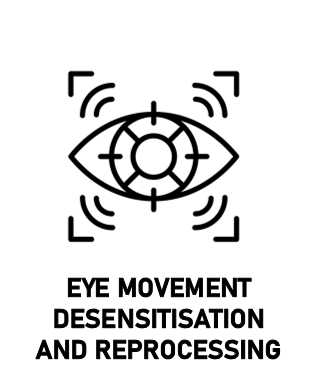Eye Movement Desensitisation and Reprocessing (EMDR) is a type of talking therapy that can be used to treat severe mental health conditions. It is typically seen as a last resort of treatment, only to be used when other extensive efforts have been exhausted,
There are many different types of talking therapy. Therefore, it is important to consider your choices. This article provides some key areas worth knowing in regards to Eye Movement Desensitisation and Reprocessing.
What is Eye Movement Desensitisation and Reprocessing?
Eye Movement Desensitisation and Reprocessing (EMDR): While more of a newer treatment, EMDR is an exciting intervention that has helped many people cope with trauma-based conditions. This therapy involves an individual moving their eyes from side-to-side, with the therapist directing their eye movements. During this, the individual recalls their traumatic experience. EMDR is believed to help an individual change how they think about the traumatic event, with the therapist aiming to facilitate change.

1. EMDR was designed by Dr. Francine Shapiro
Dr. Francine Shapiro, an American psychologist, created EMDR. She used her own experiences as a way of forming this type of therapy, using areas and concepts that she had found to be useful.
2. EMDR can be effective for many conditions
EMDR appears to be effective in treating conditions that involve elements of trauma, such as post-traumatic stress disorder.
Though it may also be used effectively in the treatment other conditions, such as substance-related disorders, depression and eating disorders.
3. EMDR involves following a therapist’s hand motions
EMDR involves a patient making side-to-side eye movements – following the movement of a therapist’s hand motions, where they’ll typically move their fingers back and forth and side to side.
This induces a state where a person is in an advanced state of REM (rapid eye movement – something that happens during sleep), and therefore may help them process memories better.
During the eye movements, the person will recall their traumatic experience, and over time, the therapist will guide their thoughts to more positive ones.
4. There are eight phases to EMDR
Dr. Shapiro created EMDR with the idea that there would be eight distinct phases to it. This includes the patient’s mental illness history being taken down, before a treatment plan is crafted.
Preparation, where certain skills are taught, takes place, before an assessment is done. The assessment aims to pinpoint the specific memories that have caused the trauma.
Then the treatment itself will take place, using techniques based around eye movement. Finally, an evaluation will take place to assess the mental state and progress of the patient.
5. EMDR is a short-term therapy
While some types of therapy – especially those that target traumatic experiences – can be long-term, potentially even for years, EMDR is designed to be a short-term therapy that aims to gain rapid results.
EMDR can therefore be very useful for those that need quick treatment. But it may not protect against relapse in the future, which is why some people prefer to do longer-term treatments.

6. EMDR treats mental pain like a physical wound
In something that has caused many to question the validity of EMDR, this form of therapy adopts an approach which suggests mental pain can be healed in a similar way to physical pain.
Like a broken leg will heal with the right treatment, EMDR takes a position that states with the right treatment, mental illness can heal in the same way.
7. EMDR has proven controversial
EMDR has proven itself to be a highly-controversial type of therapy. Many are concerned by the lack of scientific rigour behind the therapy, with a lack of conclusive evidence.
EMDR has even been lambasted as “pseudoscience” [1]. While it is gradually becoming more accepted in mainstream psychology, there are still some doubts behind its effectiveness.
8. EMDR tackles trauma head-on
EMDR can be a rather intensive treatment, as it tackles trauma head-on. Recalling traumatic experiences can be difficult, but it is something that is a crucial part of EMDR.
Recalling the trauma is necessary in EMDR, and while it can be difficult to do, in the long run, this is something that should provide the patient with therapeutic benefit.
See Also
- Therapy Home
- Everything You Need To Know About Talking Therapy
- FAQ’s About Talking Therapy
- Eye Movement Desensitisation and Reprocessing: Everything You Need to Know
- The Advantages and Disadvantages of Eye Movement Desensitisation and Reprocessing
- 8 Things You Should Know About Eye Movement Desensitisation and Reprocessing
- The Science Behind Eye Movement Desensitisation and Reprocessing
- The Eight Phases of Eye Movement Desensitisation and Reprocessing
Disclaimer
This website should be used purely for informational purposes, and does not intend to, nor should it ever, be used as a replacement for professional medical advice.
We strive to keep all of our pages updated, and ensure that our website is full of factual and in-depth information. However, we encourage you to browse this website with care.
As a reminder, this website and all content within it cannot and should not replace the advice of a trained medical professional. You can read our full disclaimer at this link.
Helplines
If you are struggling with your mental health, help is available. With the right support and treatment, you can make a recovery. For information on helplines, or if you are in a state of crisis, please visit our crisis page by clicking on the relevant link for your geographical location (United Kingdom), (United States), (International). You can also see how to get mental health treatment and the process involved by clicking this link.
References
[1] Herbert, J. D., Lilienfeld, S. O., Lohr, J. M., Montgomery, R. W., O’Donohue, W. T., Rosen, G. M., & Tolin, D. F. (2000) Science and pseudoscience in the development of eye movement desensitization and reprocessing: implications for clinical psychology. Clinical Psychology Review. 20 (8), p945-71.



































